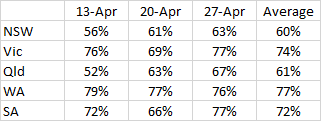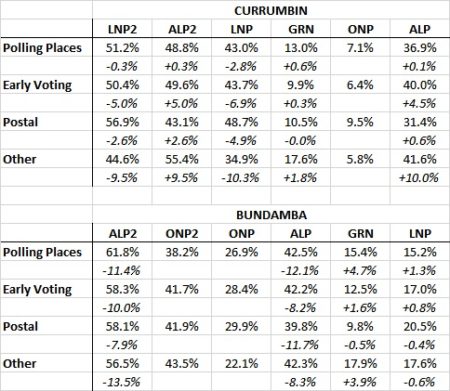The Australian ($) today provides Newspoll findings on state leaders’ handling of the coronavirus, from samples of around 520 for each mainland state plus 309 for Tasmania. The poll finds all concerned riding high, including three who strongly outperformed Scott Morrison’s ballyhooed 68% approval and 28% disapproval on the weekend. These are WA Labor Premier Mark McGowan, at 89% approval and 6% disapproval; Tasmanian Liberal Premier Peter Gutwein, at 84% approval and 11% disapproval after three months in the job; and Victorian Labor Premier Daniel Andrews, at 75% approval and 17% disapproval.
Morrison was also matched on approval and bettered on net approval by NSW Liberal Premier Gladys Berejiklian (69% approval and 23% disapproval) and SA Liberal Premier Steven Marshall (68% approval and 21% disapproval). Only Queensland Labor Premier Annastacia Palaszczuk, who faces an election in October, was below the prime ministerial par (55% approval and 39% disapproval). With due allowance for small samples, I believe McGowan’s ratings may be a record for Newspoll, or indeed for any other Australian pollster, and that Gutwein’s might have been too if not for McGowan’s.
The leaders record even stronger ratings on the specific question of handling the coronavirus outbreak: 77% rate Berejiklian as having done well, compared with 18% for badly; Andrews is at 85% and 11%; Palaszczuk is at 72% and 23%; McGowan is at 94% and 4%; Marshall is at 82% and 11%; and Gutwein is at 89% and 8%. Equivalent results are also provided for the Prime Minister, and here too Western Australians are most positive, at 73% approval and 23% disapproval, with 85% rating Morrison had handled coronavirus well compared with 14% for badly. In New South Wales, Morrison scored 67% approval and 30% disapproval, and 82% well and 16% badly for coronavirus; in Victoria, 72% approval and 26% disapproval, 83% well and 14% badly; in Queensland, 67% approval and 28% disapproval, 81% well and 17% badly; in South Australia, 70% approval and 27% disapproval, 83% well and 15% badly; and in Tasmania, 64% approval and 31% disapproval, 81% well and 18% badly.
As reported in The Guardian, the weekly Essential Research coronavirus poll provides us with a third set of small-sample findings on mainland state governments’ handling of the crisis, ranging from about 80 respondents in South Australia to 320 in New South Wales. The latest results produce combined very good and good ratings of 77% for the Victorian and South Australian governments, 76% for Western Australia, 67% for Queensland and 63% for New South Wales. The table below records the progress of this series over its three weeks, together with an averaged result which again shows Western Australia highest at 77%, followed by 74% for Victoria, 72% for South Australia, 61% for Queensland and 60% for New South Wales.
Essential Research also finds confidence in the federal government’s handling of the crisis continuing to rise, with 70% rating it good or very good, a measure that earlier progressed from 45% in late March to 65% last week. Seventy-three per cent now say they consider themselves unlikely to catch the virus, compared with 57% at the peak of concern at the end of March. In response to a list of options for budget repair, 64% supported preventing companies in offshore tax havens from receiving goverment support, but only 32% favoured removing franking credits and negative gearing, and 18% supported death duties.
On the COVIDSafe app, the weekend’s Newspoll found 21% saying they would definitely take it up, 33% that they would probably do so, 21% that they would probably not, and 18% that they would definitely not. Apart from the lower uncommitted rating, this is broadly in line with an Australia Institute poll of 1011 respondents on Thursday and Friday which had 45% saying they would and 28% that they wouldn’t. Essential Research also weighed in on the question, and found 53% saying it would limit the spread of the virus, and 46% that it would speed removal of distancing restrictions. A full set of results from Essential Research should be with us later today.
UPDATE: Full Essential Research report here.


